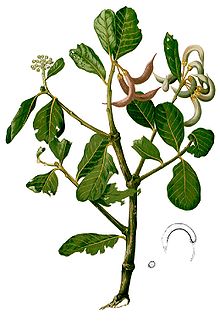Aegiceras
Appearance
| Aegiceras | |
|---|---|

| |
| Aegiceras corniculatum | |
| Scientific classification | |
| Kingdom: | Plantae |
| Clade: | Tracheophytes |
| Clade: | Angiosperms |
| Clade: | Eudicots |
| Clade: | Asterids |
| Order: | Ericales |
| Family: | Primulaceae |
| Subfamily: | Myrsinoideae |
| Genus: | Aegiceras Gaertn. |
| Species | |
|
See text | |
Aegiceras is a genus of trees and shrubs from Southeast Asia, Malesia, Australia and the Pacific Island,.[1] and in Australia, in the Northern Territory, Queensland, New South Wales, and Western Australia.[2] They occur as mangroves in coastal or estuarine areas.[2]
The genus was first described in 1788 by Joseph Gaertner.[3][4] The genus name, Aegiceras, derives from two Greek words: aix ("goat") and keras ("horn", and describes the genus as having fruits with horns like a goat.[5]
Species
[edit]There are two species accepted by Plants of the World online.[1]
- Aegiceras corniculatum (L.) Blanco
- Aegiceras floridum Roem. & Schult.
References
[edit]- ^ a b "Aegiceras Gaertn. | Plants of the World Online | Kew Science". Plants of the World Online. Retrieved 28 May 2021.
- ^ a b Harden, G.J. (1990). "PlantNET - FloraOnline; Aegiceras". plantnet.rbgsyd.nsw.gov.au. Retrieved 28 May 2021.
- ^ "Aegiceras". Australian Plant Name Index, IBIS database. Centre for Plant Biodiversity Research, Australian Government.
- ^ Sturm, J. G.; Gaertner, Joseph, 1732-1791 (1788), De fructibus et seminibus plantarum /Joseph Gaertner (in Latin), vol. 1, Sumtibus Auctoris, Typis Academiae Carolinae, pp. 216, t. 46, fig. 1, doi:10.5962/BHL.TITLE.53838, OCLC 17682598, Wikidata Q51462289
{{citation}}: CS1 maint: multiple names: authors list (link) CS1 maint: numeric names: authors list (link) - ^ Glenn Wightman (2006). "Mangroves of the Northern Territory, Australia Identification and Traditional Use". Northern Territory Botanical Bulletin. 31: 44. Wikidata Q107006058.
